英语翻译作业 苏州园林
高一介绍苏州园林的英语作文80简单

高一介绍苏州园林的英语作文80简单全文共6篇示例,供读者参考篇1The Beautiful Gardens of SuzhouHi there! My name is Lily and I'm going to tell you all about the amazing gardens in the city of Suzhou, China. Suzhou is known as the "Venice of the East" because it has lots of pretty canals and waterways. But what really makes Suzhou special are its classical gardens. These gardens are like little worlds hidden away, full of ponds, pavilions, rocks, and beautiful plants and trees. Let me describe a few of my favorite Suzhou gardens to you!The Humble Administrator's Garden is one of the biggest and most famous. It got its name because it used to belong to a humble government worker a long time ago. This garden covers over 20,000 square meters - that's huge! As you walk through the garden paths, you'll see amazing sights like the Bramble Dwelling, which is a little house built right over a pond. There's also the Lotus Blossom Bowing Down Hall, which has a big rock inside that looks just like a lotus flower bowing down. Myfavorite part is the Jade Radiance Clearing, where you can sit and watch the fish swimming in the pond.Another amazing garden is the Master of Nets Garden. This one is named after an old Chinese book about fishermen. The garden has a lot of cool names and sights based on fishing. There's the Watching-the-Catch Pavilion, where fishermen used to hang out. And the Appling Morning Pearls Corridor has little windows along the corridor that make it look like fishing nets when the sunlight shines through. My favorite area here is the Inward Gazing Scenic View Garden, with a little hill you can climb up to get a great view of the whole place.But I think the most beautiful garden is the Lion Grove Garden. It gets its name from all the amazing rocks throughout the garden that are carved to look like hungry lions! My favorite is the Husband and Wife Rocks, which show two big rocks "hugging" each other. There's also the most incredible Zigzag Bridge that twists and turns across the pond in a crazy pattern. At the center is the awesome Terrace of Cyclic Revival gazebo that looks like it's floating on the water. This garden is just full of cool surprises around every corner.These classical gardens of Suzhou are so peaceful and relaxing. You can stroll along the winding paths, look at thepretty pavilions and ponds, and feel like you've stepped into another world. The best part is spotting all the hidden details and symbols in the gardens that represent things from Chinese culture and philosophy. Like the pavilion names often come from famous poems or stories. And the garden layouts are designed to represent ideas like harmony with nature.The Suzhou gardens took hundreds of years to design and build using special landscaping styles. The gardens combine plants, rocks, water, and architecture in really creative ways. It's amazing how every little pond, path, and pavilion is carefully placed just right. The gardens look natural, but are actually very precisely planned out!One of my favorite things about the gardens is getting to see all the cool rocks. The rocks are brought in from lakes and mountains around China. Many of them have poetic names because of their unique shapes that look like things in nature. There are rocks carved to look like elephants, lions, mountains, and even people! The rocks are arranged in the gardens along with carefully pruned trees and plants to look like miniature landscapes. Some of the "spirit rocks" in the gardens are even worshipped because people think they have spirits living inside.There are also lots of fun details to hunt for, like decorative windows, doorways, bridges, and corridors all designed in different styles. Everything from the roof tiles to the carved wood and stone is beautiful. You'll often see paintings and calligraphy artworks hanging up too. It's easy to spend hours just wandering around admiring all the decorations and architecture!I hope you can visit the classical gardens of Suzhou yourself someday. They are such peaceful oases in the middle of the busy city. Wandering through the winding paths surrounded by ponds and ancient pavilions really makes you feel far away from the modern world. You can sit and watch the koi fish swim lazily in the water. Or you can look for turtles basking on the rocks. It's a whole new world hidden within the gardens' walls! Just make sure to wear good walking shoes because there is so much ground to cover. And don't forget to make a wish by tossing a coin into the water!So those are some of the highlights of the most beautiful classical gardens in Suzhou. They really are remarkable places that let you experience traditional Chinese landscaping and architecture at its finest. I hope you enjoyed learning about these gardens as much as I enjoyed exploring them! Let me know ifyou ever get to visit Suzhou - I'm sure you'll love the gardens just as much as me.篇2Gardens of Suzhou: A Magical World of BeautyHi there! My name is Lily, and I'm a high school student who loves exploring the wonders of nature. Recently, I had the chance to visit the famous gardens of Suzhou, and let me tell you, it was an experience like no other! These gardens are true masterpieces, and I can't wait to share my adventure with you.Imagine stepping into a world where every corner is a work of art, where nature and human ingenuity blend seamlessly. That's exactly what the Suzhou gardens are all about. These ancient gardens have been around for centuries, and they have captured the hearts and imaginations of people from all over the world.One of the first gardens I visited was the Humble Administrator's Garden, and boy, was it anything but humble! This garden is huge, covering an area of about 5 acres (2 hectares). As soon as I stepped through the gates, I was greeted by a breathtaking landscape of winding paths, serene ponds, and meticulously designed pavilions.What struck me the most about this garden was the way it played with perspectives. Every turn revealed a new view, a new surprise. One minute, I was gazing at a tranquil pond with koi fish swimming gracefully, and the next, I was admiring the intricate carvings on a stone bridge or the delicate paintings adorning the walls of a pavilion.But the gardens of Suzhou are not just about visual beauty; they're also about creating an atmosphere of peace and tranquility. As I wandered through the Humble Administrator's Garden, I couldn't help but feel a sense of calm wash over me. The sound of water trickling from the fountains, the gentle rustling of the trees, and the melodic chirping of birds all combined to create a soothing symphony that quieted my mind and allowed me to fully appreciate the beauty around me.Next, I visited the Lingering Garden, and let me tell you, it truly lived up to its name. This garden is smaller than the Humble Administrator's Garden, but no less enchanting. Every corner was a delight, with intricate rockeries, winding pathways, and charming pavilions that invited visitors to linger and soak in the peaceful atmosphere.One of my favorite spots in the Lingering Garden was the Scholar's Courtyard. This secluded area was designed to providea tranquil space for scholars to study and contemplate. As I sat on one of the stone benches, surrounded by lush greenery and the gentle sound of a nearby waterfall, I could almost imagine the scholars of old, poring over ancient texts and pondering the mysteries of the universe.But the gardens of Suzhou are not just about beauty and tranquility; they're also about ingenuity and creativity. These gardens were designed with incredible attention to detail, incorporating elements of feng shui, traditional Chinese architecture, and landscape design.For example, in the Lion Grove Garden, I marveled at the intricate rock formations that were carefully arranged to create the illusion of towering mountains and cascading waterfalls. It was almost like stepping into a miniature world, where nature's grandeur was captured within the confines of a garden.And let's not forget about the Master of Nets Garden, which is renowned for its exquisite use of water features. This garden is built around a large pond, and its pavilions, bridges, and pathways are all designed to createa harmonious relationship with the water, allowing visitors to feel a deep connection with nature.As I explored these gardens, I couldn't help but feel a sense of wonder and appreciation for the people who created them. These weren't just gardens; they were works of art, carefully crafted to evoke emotions, tell stories, and inspire contemplation.One of the things that struck me the most was how the gardens managed to seamlessly blend natural elements with man-made structures. The rocks, ponds, and plants were not just haphazardly placed; they were arranged with a keen eye for composition and balance, creating a harmonious and visually stunning landscape.And let's not forget about the cultural significance of these gardens. They are not just beautiful outdoor spaces; they are living museums that preserve and celebrate the rich heritage of Chinese garden design. As I wandered through the gardens, I couldn't help but feel a sense of connection to the centuries of history and tradition that had gone into their creation.Overall, my visit to the Suzhou gardens was an unforgettable experience. It was a journey through a world of beauty, tranquility, and ingenuity, where nature and human creativity intertwined to create something truly magical. These gardens are not just tourist attractions; they are living works of art thatinspire awe, wonder, and a deep appreciation for the natural world and the human spirit.If you ever get the chance to visit the Suzhou gardens, I highly recommend it. It's an experience that will stay with you forever, reminding you of the incredible beauty and creativity that humans are capable of when they work in harmony with nature.篇3My Favorite Place: The Classical Gardens of SuzhouHi there! My name is Xiaoming and I'm a high school student in Suzhou, which is a city not too far from Shanghai. I absolutely love living here because Suzhou is famous for its classical gardens that date back hundreds of years. These gardens are honestly one of my favorite places in the whole world!Suzhou has a really long history of building beautiful gardens going all the way back to the 6th century. The city used to be the capital of Wu Kingdom and was a super important place for culture, art, and trade on the Silk Road. A lot of rich merchants, scholars, and government officials lived here and they built amazing gardens as places to relax, study, and enjoy nature.The gardens combine natural landscapes like ponds, rocks, trees and flowers with man-made structures like pavilions, bridges, and corridors. The landscaping is absolutely stunning and makes you feel like you're in a tranquil paradise. The gardens are designed based on ancient Chinese philosophies and incorporate elements like yin and yang, fengshui principles, and references to Taoism beliefs.My personal favorite garden in Suzhou is the Humble Administrator's Garden. It was first created in 1513 by a former Buddhist monk. The name comes from the saying that only humble people can truly appreciate its beauty. The garden covers over 50,000 square meters and has gorgeous scenery no matter which season you visit.In the spring, the garden comes alive with colorful blossoms like peach, plum, and lotus flowers. The summer brings lush green forestry with bamboo groves swaying in the breeze. Fall has breathtaking red maple trees and vibrant chrysanthemums. Even in winter, the bare branches are beautiful covered in frost and snow.There are so many amazing structures and landscapes to discover like the Celestial Mirror Pond, Rhyme-Prose Garden, Bamboo Blade Corridor, and the Viewing Dwelling. My favorite isprobably the Dwelling Amidst the Purity and Fragrance area which has incredible bonsai trees that are hundreds of years old! The garden also has lots of carvings, paintings, and calligraphy on the walls celebrating nature's beauty.Another spectacular garden is the Lingering Garden, which used to be a private estate for senior government officials back in the 1500s. My class went on a field trip there and I was totally blown away. The garden is divided into four separate sections representing the four seasons. It blends Eastern and Western design styles with corridors that meander like a maze.One part I loved was the Celestial Virgin Residence with its elegant pavilions, rock sculptures, and winding covered walkways. The central focus is the Grand Rockery which towers over 20 feet high and is made from these gigantic limestone rocks weighing up to 100 tons! It's amazing that all the stones were carefully selected and transported here so long ago.The gardens of Suzhou are incredible living museums that really connect you with China's rich cultural history and reverence for nature. Just strolling through the winding paths and gazing at panoramic views of ponds, pavilions and pine trees immediately melts away any stress. You can't help but feel peaceful and serene.I feel so fortunate to grow up near such magical and timeless gardens. Whether I'm relaxing with friends, studying for exams, or just looking for inspiration, the Suzhou gardens never fail to rejuvenate my spirit. The intricate designs and profound philosophies behind each garden open my mind to think deeply about harmony with nature.These ancient gardens are such a treasured part of Chinese heritage and I hope generations to come can continue appreciating their beauty for centuries more. To me, the gardens of Suzhou truly capture the essence of Chinese aesthetics, culture and serenity. I'm always excited to visit and be transported to a realm of peace and tranquility!篇4The Wonderful Suzhou GardensHi there! My name is Lily, and I recently went on a school trip to the beautiful city of Suzhou in China. It's famous for its amazing gardens, and I'm so excited to tell you all about them!Suzhou is known as the "Venice of the East" because it has lots of lovely canals and waterways. The gardens there are like little pieces of paradise on Earth. They've been around forhundreds of years, and each one is carefully designed to be a peaceful oasis of nature and harmony.One of the most famous gardens we visited is called the Humble Administrator's Garden. Can you believe that name? It sounds like the kind of place where a humble administrator would live and work, but it's actually a breathtakingly beautiful garden instead!The Humble Administrator's Garden is huge – it covers over 50,000 square meters! That's about the size of seven football fields put together. As we walked through the garden, we saw lots of different areas, like pretty pavilions, winding pathways, ancient trees, and lovely ponds with little bridges over them.One of my favorite parts was the corridor called "The Drunken Corridor." It's a long, winding corridor with lots of twists and turns, and the roof is all twisted and slanted in a funny way, almost like it's drunk! Our guide told us that the corridor was built like that on purpose, to show that even simple things like a corridor can be beautiful and interesting if they're designed with creativity.Another garden we visited was called the Lion Grove Garden. This one was built in the 1300s, which means it's over 700 years old! Can you imagine? It's like stepping back in time when youwalk around the garden. There are lots of cool rock formations, like a huge rock that looks like a lion, which is how the garden got its name.One of the most amazing things about the Lion Grove Garden is the intricate carvings on the rocks. The artists who built the garden spent years carefully carving designs and patterns into the rocks, and they're so detailed and beautiful. It's like the rocks themselves are works of art!But my absolute favorite garden was the Master of Nets Garden. It's a bit smaller than the others, but it's so peaceful and serene. The whole garden is designed around a lovely pond, and there are little bridges and pavilions dotted around the edges. The best part is the "Fishing Villa," which is a little building right on the pond where people used to sit and fish.As we walked around the Master of Nets Garden, our guide told us all about the different plants and flowers we saw. There were lotus flowers blooming in the pond, and beautiful bonsai trees that were hundreds of years old. It was like stepping into a living painting – everything was so perfectly arranged and beautiful.One of the coolest things about the Suzhou gardens is how they use water to create different effects. In the Master of NetsGarden, there are little streams and waterfalls that make soothing gurgling sounds as the water flows. And in the Lion Grove Garden, there are these amazing rocks called "toad rocks" that stick up out of the water and look like little islands.The gardens also have lots of cool details, like intricate carvings on the walls and buildings, and beautiful tiles and pottery scattered around. It's like every inch of the gardens is a work of art!Walking through the Suzhou gardens was like stepping into a fairytale world. The gardens are so peaceful and serene, and they're designed to be in perfect harmony with nature. Even though they're hundreds of years old, they still feel fresh and alive, like little oases in the middle of the busy city.I feel so lucky to have had the chance to visit these amazing gardens. They're true masterpieces of Chinese gardening and architecture, and they're a window into the rich history and culture of Suzhou. If you ever get the chance to visit, I really hope you'll go and experience the magic for yourself!That's all for now, but I'll be sure to tell you all about the next amazing place I get to visit. Until then, happy exploring!篇5My Trip to the Beautiful Gardens of SuzhouLast summer, my family and I went on a trip to Suzhou, a city in eastern China. Suzhou is famous for its classical gardens that were built hundreds of years ago. I was very excited to visit these gardens because I had learned about them in school.The first garden we visited was the Humble Administrator's Garden. This garden was built in the 1500s and it is the biggest of Suzhou's gardens. As soon as we entered, I was amazed by how pretty and peaceful it was. There were pavilions, ponds, bridges, and beautiful rocks everywhere! My favorite part was the "Drunken Bazaar" area, which had narrow winding paths going between small shops and restaurants. It felt like being in a little village from long ago.Next, we went to the Lion Grove Garden. This garden is known for its amazing rocks and caves. The rocks came from a lake and they are millions of years old! Some of the rocks were carved into shapes like lions, elephants, and even a Chinese dragon. There was one rock called the "Hungry Bowl" rock that looked just like a big bowl. My little brother and I had fun exploring all the tunnels and caves made between the rocks.After that, we visited the Master of Nets Garden. This garden used to belong to a retired fisherman who was an expert atnetting fish. Everything in the garden was built to look like fishing scenes. There was a pond meant to look like the ocean, with rocks set up like little islands. My favorite part was the "Net Master's Cottage" which showed what the fisherman's little house looked like. It had tiny windows and a thatched roof. I felt like I had gone back in time!The next garden was the Lingering Garden. This one felt very peaceful and relaxing. It had lots of bonsai trees, flowering plants, and winding covered walkways. One area called the "Celestial Courtyard" had beautiful carvings of animals, clouds, and other nature scenes on the walls. My dad liked this garden the best because he enjoys bonsai trees.On our last day, we went to the Garden of Cultivation. The buildings in this garden were built to look studious and serious to encourage hard work. There were several small study rooms and a big opera stage called the "Studio of Exhausted Breezes". My favorite area was called the "Potted Landscape" where there were pots and pots of tiny trees and plants arranged like a real garden scene. It was amazing how the gardeners had made the little trees look just like big ones!Visiting the classical gardens of Suzhou was one of the highlights of our trip to China. Each garden felt like beingtransported to a different world from long ago. The gardens were so peaceful, pretty, and interesting. I loved exploring all the pavilions, ponds, rocks, and miniature scenery. If you ever get a chance to visit Suzhou, you have to see the gardens! They really give you a taste of China's beautiful culture and history.篇6My Trip to the Gardens of SuzhouHi everyone! My name is Xiaoming and I'm 10 years old. Last summer, my family took a trip to Suzhou, which is a beautiful city not too far from Shanghai. Suzhou is famous for its amazing classical gardens that were built hundreds of years ago. I got to visit several of these gardens and I want to tell you all about them!The first garden we went to see was called the Humble Administrator's Garden. It was built way back in the 1500s during the Ming Dynasty. As soon as we walked in, I could tell this garden was going to be incredible. There were pavilions, ponds, bridges, and plants everywhere! My favorite part was definitely all the ponds. The water was so clear and there were beautiful fish swimming around. We even saw a few lotus flowers floating on top.One of the coolest things about the Humble Administrator's Garden were all the awesome rock formations. There were these huge, crazy shaped rocks everywhere that had been brought from lakes and mountains all over China hundreds of years ago. My little brother pretended they were dinosaurs! The garden also had lots of bamboo forests and trees that created nice shady walking paths. It felt like being in a secret jungle world in the middle of the city.The next garden we visited was the Lion Grove Garden, which was built in the 1300s. This one had way more rock formations than the Humble Administrator's Garden. Some of the rocks were taller than a whole house! There were also lots of little caves and tunnels carved under and around the rocks that we could explore. My favorite part was climbing up to the top of one of the rock mountains to get an amazing view of the whole garden. So cool!The Lion Grove Garden also had a huge pond right in the center with an island inside it. We took a little boat ride around the island and got to see it up close. There was a leaning pavilion on the island that looked like it was about to fall over into the water! But it had been built that way on purpose hundreds ofyears ago as a clever trick. The ancient Chinese garden architects were so talented.After those two gardens, we went to the Garden of the Humble Life which was absolutely massive. It used to be the private garden of a rich family who lived there hundreds of years ago. My favorite area was the Quarry Hill, which had tons of boulders and rock formations, as well as streams, waterfalls and ponds scattered everywhere. We played a game of trying to spot all the different creatures that had been carved into the rocks, like dragons, elephants and even little people!The Garden of the Humble Life also had an indoor garden section with potted plants everywhere. They even had trees growing inside the building! It was like being in a jungle house. I also loved seeing all the miniature gardens they had created inside simple clay pots. The ancient gardeners were incredible artists.Visiting the classical gardens of Suzhou was one of the highlights of my summer vacation. They were all so beautiful, peaceful and amazing to explore. Each garden felt like stepping into a secret wonderland with gorgeous scenery around every corner. The ancient Chinese people who built these gardens were true geniuses when it came to gardening and artwork. If you everget a chance to visit Suzhou, you have to spend time wandering through the classical gardens. It's an adventure you'll never forget!。
苏州园林英文应用文
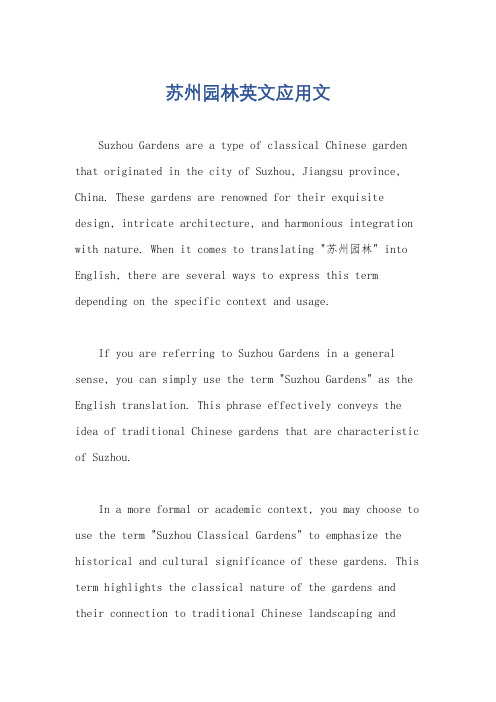
苏州园林英文应用文Suzhou Gardens are a type of classical Chinese garden that originated in the city of Suzhou, Jiangsu province, China. These gardens are renowned for their exquisite design, intricate architecture, and harmonious integration with nature. When it comes to translating "苏州园林" into English, there are several ways to express this term depending on the specific context and usage.If you are referring to Suzhou Gardens in a general sense, you can simply use the term "Suzhou Gardens" as the English translation. This phrase effectively conveys the idea of traditional Chinese gardens that are characteristic of Suzhou.In a more formal or academic context, you may choose to use the term "Suzhou Classical Gardens" to emphasize the historical and cultural significance of these gardens. This term highlights the classical nature of the gardens and their connection to traditional Chinese landscaping andarchitectural principles.Another possible translation is "Suzhou-style Gardens," which captures the distinctive style and characteristics of the gardens associated with Suzhou. This term isparticularly useful when you want to emphasize the unique features and design elements that define Suzhou Gardens.It's important to note that the translation of "苏州园林" into English may vary depending on the specific nuances and connotations you wish to convey. In any case, the English translation should accurately reflect the rich heritage and artistic beauty of Suzhou Gardens.In summary, the English translations of "苏州园林" can include "Suzhou Gardens," "Suzhou Classical Gardens," or "Suzhou-style Gardens," among other possibilities. Each of these translations effectively communicates the cultural and aesthetic essence of the traditional Chinese gardens found in Suzhou.。
苏州园林英语四级作文
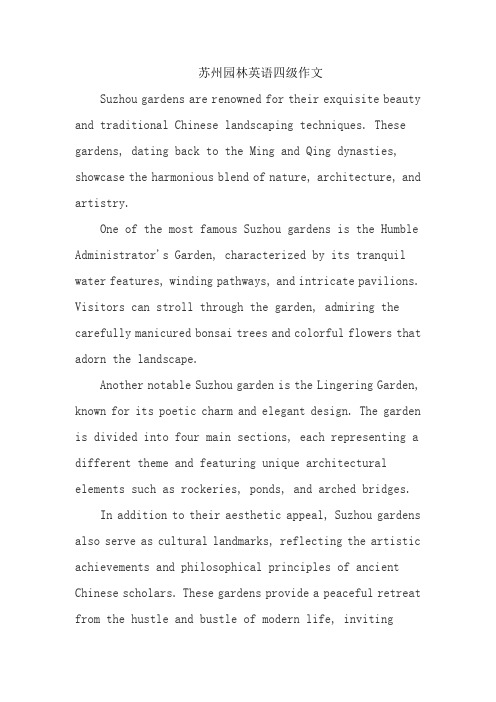
苏州园林英语四级作文Suzhou gardens are renowned for their exquisite beauty and traditional Chinese landscaping techniques. These gardens, dating back to the Ming and Qing dynasties, showcase the harmonious blend of nature, architecture, and artistry.One of the most famous Suzhou gardens is the Humble Administrator's Garden, characterized by its tranquil water features, winding pathways, and intricate pavilions. Visitors can stroll through the garden, admiring the carefully manicured bonsai trees and colorful flowers that adorn the landscape.Another notable Suzhou garden is the Lingering Garden, known for its poetic charm and elegant design. The garden is divided into four main sections, each representing a different theme and featuring unique architectural elements such as rockeries, ponds, and arched bridges.In addition to their aesthetic appeal, Suzhou gardens also serve as cultural landmarks, reflecting the artistic achievements and philosophical principles of ancient Chinese scholars. These gardens provide a peaceful retreat from the hustle and bustle of modern life, invitingvisitors to ponder the beauty of nature and the wisdom of the past.中文翻译:苏州园林以其精致的美丽和传统的中国园林技术而闻名。
关于苏州园林的英语作文
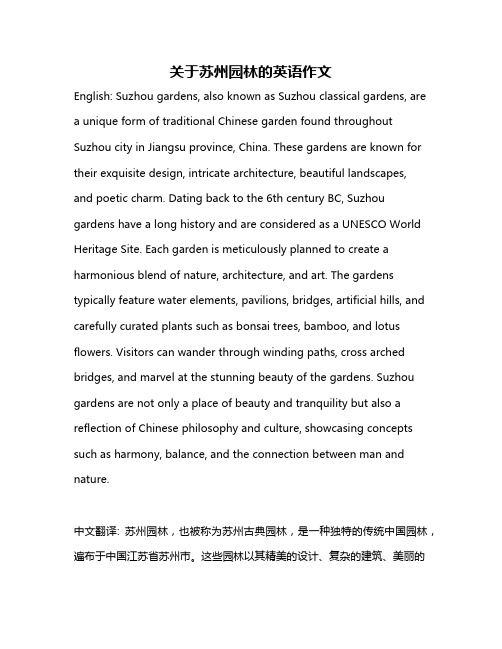
关于苏州园林的英语作文English: Suzhou gardens, also known as Suzhou classical gardens, are a unique form of traditional Chinese garden found throughout Suzhou city in Jiangsu province, China. These gardens are known for their exquisite design, intricate architecture, beautiful landscapes,and poetic charm. Dating back to the 6th century BC, Suzhou gardens have a long history and are considered as a UNESCO World Heritage Site. Each garden is meticulously planned to create a harmonious blend of nature, architecture, and art. The gardens typically feature water elements, pavilions, bridges, artificial hills, and carefully curated plants such as bonsai trees, bamboo, and lotus flowers. Visitors can wander through winding paths, cross arched bridges, and marvel at the stunning beauty of the gardens. Suzhou gardens are not only a place of beauty and tranquility but also a reflection of Chinese philosophy and culture, showcasing concepts such as harmony, balance, and the connection between man and nature.中文翻译: 苏州园林,也被称为苏州古典园林,是一种独特的传统中国园林,遍布于中国江苏省苏州市。
苏州园林的英文作文

苏州园林的英文作文英文:Suzhou gardens are one of the most famous types of Chinese gardens. They are known for their exquisite design, beautiful scenery, and cultural significance. As a resident of Suzhou, I am proud to say that these gardens are a true masterpiece of Chinese art and architecture.The Suzhou gardens are famous for their unique layout, which combines natural elements with man-made structures. For example, the Humble Administrator's Garden features a central pond surrounded by rocks, trees, and pavilions. The garden's design is meant to mimic the natural landscape, while at the same time creating a harmonious and peaceful environment.In addition to their beautiful design, Suzhou gardens also have cultural significance. They were built during the Ming and Qing dynasties, and were often used as a place forscholars and artists to relax and find inspiration. Many famous poets and painters have visited these gardens, and their works have been influenced by the beauty and tranquility of the surroundings.Overall, Suzhou gardens are a true gem of Chinese culture. They showcase the country's rich history and artistry, and are a testament to the beauty and ingenuity of Chinese architecture.中文:苏州园林是中国最著名的园林之一,以其精美的设计、美丽的风景和文化意义而闻名。
苏州园林作文英语
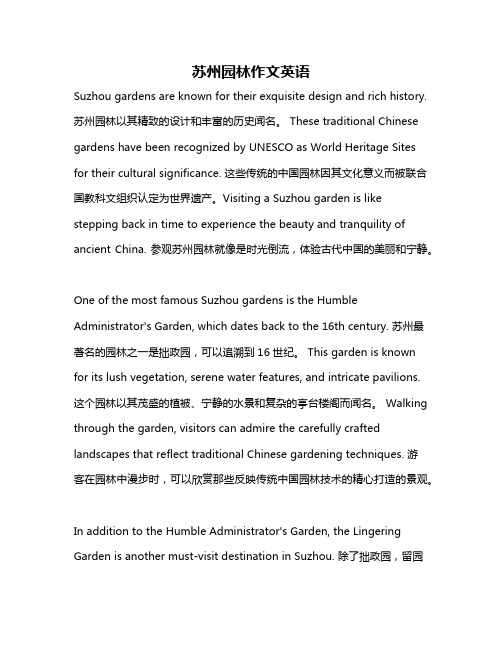
苏州园林作文英语Suzhou gardens are known for their exquisite design and rich history. 苏州园林以其精致的设计和丰富的历史闻名。
These traditional Chinese gardens have been recognized by UNESCO as World Heritage Sites for their cultural significance. 这些传统的中国园林因其文化意义而被联合国教科文组织认定为世界遗产。
Visiting a Suzhou garden is like stepping back in time to experience the beauty and tranquility of ancient China. 参观苏州园林就像是时光倒流,体验古代中国的美丽和宁静。
One of the most famous Suzhou gardens is the Humble Administrator's Garden, which dates back to the 16th century. 苏州最著名的园林之一是拙政园,可以追溯到16世纪。
This garden is known for its lush vegetation, serene water features, and intricate pavilions. 这个园林以其茂盛的植被、宁静的水景和复杂的亭台楼阁而闻名。
Walking through the garden, visitors can admire the carefully crafted landscapes that reflect traditional Chinese gardening techniques. 游客在园林中漫步时,可以欣赏那些反映传统中国园林技术的精心打造的景观。
苏州园林的英文作文

苏州园林的英文作文The classical gardens of Suzhou, enchanting masterpieces of landscape architecture, stand as a testament to the profound connection between humanity and nature that has captivated artists, poets, and philosophers for centuries. Nestled in the heart of Jiangsu province, these gardens, recognized as UNESCO World Heritage Sites, offer a glimpse into a world where artistry and nature coalesce in perfect harmony. Their design principles, steeped in history and refined over generations, reveal a deep understanding of aesthetics and the human desire to create idyllic spaces that inspire contemplation and tranquility. The genesis of Suzhou's gardens can be traced back to the 6th century, during the Sui Dynasty, when the city flourished as a cultural and economic hub. Over time, the tradition of private garden creation blossomed, particularly among affluent merchants and scholar-officials seeking respite from the bustling city life. Each garden became a microcosm of the natural world, meticulously crafted to evoke a sense of serenity and escape. The Song Dynasty (960-1279) witnessed a golden age in garden design, with scholars and artists further refining the art form, incorporating philosophical principles and literary allusions into the landscapes. One of the hallmarks of Suzhou's gardens is the artful use of space and the seamless integration of various elements. Unlike expansive European gardens, which often emphasize grandeur and symmetry, Suzhou's gardens are characterized by their compact size and asymmetrical layouts. Winding pathways lead visitors through carefully orchestrated scenes, revealing unexpected vistas at every turn. Walls, traditionally whitewashed, serve as blank canvases for the interplay of light and shadow, while strategically placed windows frame picturesque views, transforming the garden into a living scroll painting. Water plays a pivotal role in the gardens, serving as a unifying element and a source of both visual and auditory delight. Ponds, often stocked with colorful koi carp, reflect the sky and surrounding structures, creating an illusion of expanded space and depth.Carefully positioned rocks, chosen for their shape and texture, emerge from the water, adding an element of rugged natural beauty. The gentle sound of water flowing over sculpted stones or trickling through bamboo pipes creates a soothing ambiance, inviting contemplation and relaxation. Plants are meticulously chosenand arranged to complement the architectural features and enhance the overall aesthetic harmony. Trees, pruned and shaped over years, provide shade and add verticality to the composition. Fragrant flowers, such as plum blossoms, peonies, and chrysanthemums, add bursts of color and scent, enriching the sensory experience. Bamboo, with its graceful form and rustling leaves, evokes a sense of tranquility and connection with the natural world. The architecture within Suzhou's gardens is as integral to the design as the natural elements. Pavilions, often strategically placed on islands or beside water features, provide spaces for rest, reflection, or social gatherings. Their intricate latticework windows allow for the gentle flow of air and provide glimpses of the surrounding scenery. Covered walkways, adorned with carved beams and tiled roofs, offer shelter from the elements and guide visitors through the garden's meandering paths. Rock formations, sometimes arranged to resemble miniature mountains or grottoes, add a sense of drama and provide opportunities for exploration and discovery. Visiting a Suzhou garden is akin to stepping into a living work of art. It is an immersive experience that engages all the senses and transports visitors to a realm of beauty, tranquility, and refined elegance. The meticulous attention to detail, the harmonious blend of natural and man-made elements, and the profound symbolism embedded in every design choice reveal the depth of Chinese culture and its enduring reverence for the natural world. These gardens stand as a timeless reminder of the enduring power of human creativity and the profound connection between humanity and the environment. They offer a sanctuary for contemplation, a source of artistic inspiration, and a testament to the enduring legacy of Chinese landscape architecture.。
关于苏州园林英语作文

关于苏州园林英语作文英文回答:Suzhou Gardens, a UNESCO World Heritage Site, are renowned for their exquisite beauty and harmonious blend of nature and architecture. These gardens, dating back to the 11th century, are a testament to the ingenuity and artistry of ancient Chinese landscape architects.One of the key characteristics of Suzhou Gardens istheir integration of natural elements, such as water, rocks, and plants. Water is a prominent feature in many gardens, with ponds, canals, and waterfalls creating a serene and tranquil atmosphere. Rocks, carefully placed to resemble mountains or cliffs, add a sense of depth and grandeur to the landscape. A variety of plants, including trees, shrubs, and flowers, provide a vibrant and colorful display throughout the year.Another defining feature of Suzhou Gardens is their useof architectural elements to frame and enhance the natural beauty. Pavilions, bridges, and terraces are strategically placed to provide visitors with different perspectives of the garden and to create a sense of movement and flow. The architecture, often decorated with intricate carvings and paintings, is in perfect harmony with the surrounding environment, creating a cohesive and aesthetically pleasing space.Suzhou Gardens are also known for their symbolic and philosophical significance. The placement of rocks, water, and plants is often influenced by Taoist and Buddhist principles, representing the balance and harmony of the universe. Visitors can stroll through the gardens at their leisure, contemplating the beauty of nature and the meaning behind the various elements.中文回答:苏州园林。
苏州园林的英语作文
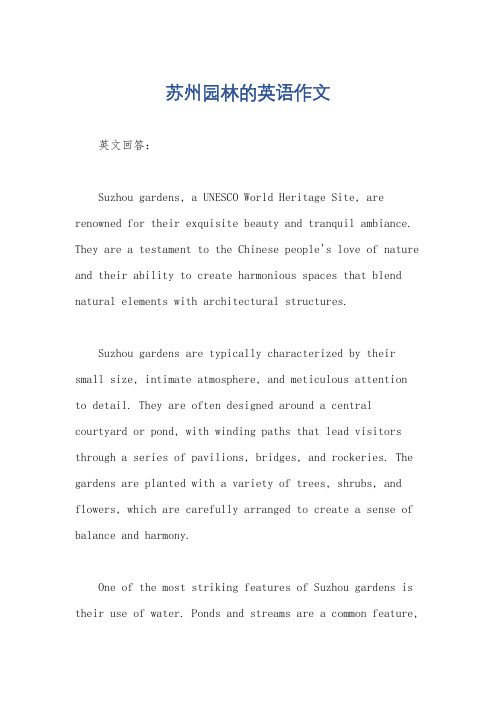
苏州园林的英语作文英文回答:Suzhou gardens, a UNESCO World Heritage Site, are renowned for their exquisite beauty and tranquil ambiance. They are a testament to the Chinese people's love of nature and their ability to create harmonious spaces that blend natural elements with architectural structures.Suzhou gardens are typically characterized by their small size, intimate atmosphere, and meticulous attention to detail. They are often designed around a central courtyard or pond, with winding paths that lead visitors through a series of pavilions, bridges, and rockeries. The gardens are planted with a variety of trees, shrubs, and flowers, which are carefully arranged to create a sense of balance and harmony.One of the most striking features of Suzhou gardens is their use of water. Ponds and streams are a common feature,and they are often used to reflect the surrounding architecture and create a sense of depth and tranquility. The gardens also often feature waterfalls and fountains, which add to the overall ambiance of the space.Suzhou gardens are also known for their use of architecture. The pavilions and bridges are often designed in a traditional Chinese style, with curved roofs and intricate carvings. The buildings are often painted in bright colors, which adds to the overall beauty of the gardens.Suzhou gardens have been a source of inspiration for artists and poets for centuries. They have been featured in numerous paintings, poems, and songs. The gardens are also a popular destination for tourists, who come from all over the world to experience their beauty and tranquility.中文回答:苏州园林,联合国教科文组织世界遗产,以其精致的美丽和宁静的环境著称。
苏州园林英语作文
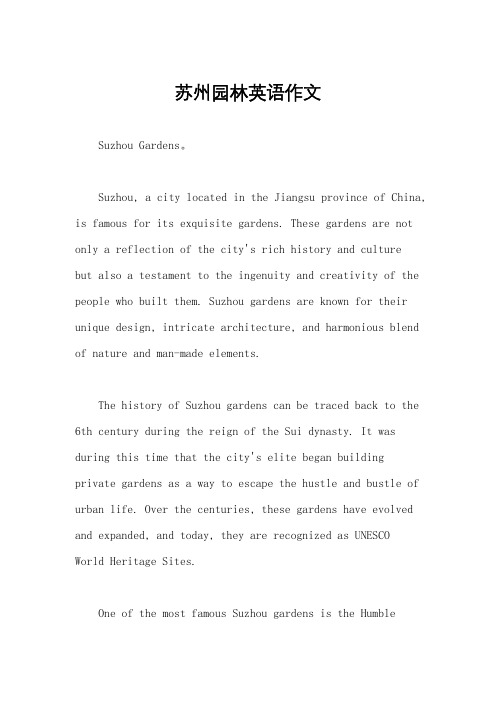
苏州园林英语作文Suzhou Gardens。
Suzhou, a city located in the Jiangsu province of China, is famous for its exquisite gardens. These gardens are not only a reflection of the city's rich history and culturebut also a testament to the ingenuity and creativity of the people who built them. Suzhou gardens are known for their unique design, intricate architecture, and harmonious blend of nature and man-made elements.The history of Suzhou gardens can be traced back to the 6th century during the reign of the Sui dynasty. It was during this time that the city's elite began buildingprivate gardens as a way to escape the hustle and bustle of urban life. Over the centuries, these gardens have evolved and expanded, and today, they are recognized as UNESCOWorld Heritage Sites.One of the most famous Suzhou gardens is the HumbleAdministrator's Garden. This garden, covering an area of 5 hectares, is the largest and most renowned classical garden in Suzhou. It is divided into three main sections: the eastern garden, the central garden, and the western garden. Each section has its own unique features, such as pavilions, ponds, bridges, and rockeries, all carefully arranged to create a tranquil and harmonious atmosphere.Another notable Suzhou garden is the Lingering Garden, which was originally built during the Ming dynasty. This garden is famous for its intricate layout, diverse plant species, and beautiful architecture. The garden is divided into four main sections: the central, eastern, western, and northern parts, each with its own distinct characteristics. The Lingering Garden is a perfect example of thetraditional Chinese garden design philosophy, which emphasizes the harmonious coexistence of man and nature.In addition to the Humble Administrator's Garden andthe Lingering Garden, there are many other beautifulgardens in Suzhou, each with its own unique charm and history. These gardens are not only popular touristattractions but also serve as important cultural and historical landmarks for the city.The Suzhou gardens are not only a testament to thecity's rich history and culture but also a source of inspiration for artists, poets, and scholars throughout the ages. The unique design and meticulous craftsmanship of these gardens have left a lasting impression on visitors from all over the world. It is no wonder that Suzhou gardens are often referred to as "paradise on earth" and continue to be a source of pride for the people of Suzhou.In conclusion, Suzhou gardens are a true reflection of the city's rich history, culture, and creativity. These gardens are not only a testament to the ingenuity and craftsmanship of the people who built them but also a source of inspiration and admiration for visitors from all over the world. Suzhou gardens are a must-visit for anyone interested in experiencing the beauty and tranquility of traditional Chinese garden design.。
苏州园林英语小范文
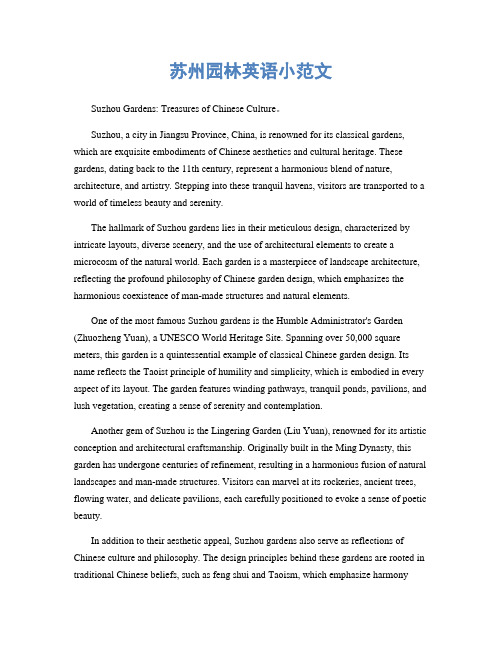
苏州园林英语小范文Suzhou Gardens: Treasures of Chinese Culture。
Suzhou, a city in Jiangsu Province, China, is renowned for its classical gardens, which are exquisite embodiments of Chinese aesthetics and cultural heritage. These gardens, dating back to the 11th century, represent a harmonious blend of nature, architecture, and artistry. Stepping into these tranquil havens, visitors are transported to a world of timeless beauty and serenity.The hallmark of Suzhou gardens lies in their meticulous design, characterized by intricate layouts, diverse scenery, and the use of architectural elements to create a microcosm of the natural world. Each garden is a masterpiece of landscape architecture, reflecting the profound philosophy of Chinese garden design, which emphasizes the harmonious coexistence of man-made structures and natural elements.One of the most famous Suzhou gardens is the Humble Administrator's Garden (Zhuozheng Yuan), a UNESCO World Heritage Site. Spanning over 50,000 square meters, this garden is a quintessential example of classical Chinese garden design. Its name reflects the Taoist principle of humility and simplicity, which is embodied in every aspect of its layout. The garden features winding pathways, tranquil ponds, pavilions, and lush vegetation, creating a sense of serenity and contemplation.Another gem of Suzhou is the Lingering Garden (Liu Yuan), renowned for its artistic conception and architectural craftsmanship. Originally built in the Ming Dynasty, this garden has undergone centuries of refinement, resulting in a harmonious fusion of natural landscapes and man-made structures. Visitors can marvel at its rockeries, ancient trees, flowing water, and delicate pavilions, each carefully positioned to evoke a sense of poetic beauty.In addition to their aesthetic appeal, Suzhou gardens also serve as reflections of Chinese culture and philosophy. The design principles behind these gardens are rooted in traditional Chinese beliefs, such as feng shui and Taoism, which emphasize harmonywith nature and the pursuit of spiritual tranquility. Walking through the winding corridors and scenic vistas of Suzhou gardens, one can gain insights into the cultural values and artistic expressions of ancient China.Moreover, Suzhou gardens provide a sanctuary from the hustle and bustle of modern life, offering visitors a retreat where they can reconnect with nature and find inner peace. Amidst the tranquil ponds and fragrant flowers, one can escape the distractions of the outside world and experience a sense of calmness and rejuvenation.In conclusion, Suzhou gardens are not merely places of beauty but also repositories of Chinese culture and heritage. Through their exquisite design, artistic craftsmanship, and profound philosophical implications, these gardens continue to inspire and enchant visitors from around the world. As timeless treasures of Chinese civilization, Suzhou gardens remind us of the enduring wisdom and creativity of our ancestors, inviting us to appreciate the harmony and beauty of nature.。
关于苏州园林的英语作文
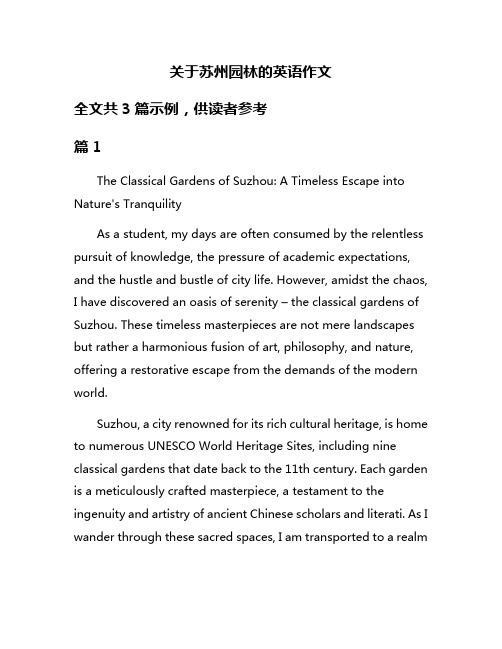
关于苏州园林的英语作文全文共3篇示例,供读者参考篇1The Classical Gardens of Suzhou: A Timeless Escape into Nature's TranquilityAs a student, my days are often consumed by the relentless pursuit of knowledge, the pressure of academic expectations, and the hustle and bustle of city life. However, amidst the chaos, I have discovered an oasis of serenity – the classical gardens of Suzhou. These timeless masterpieces are not mere landscapes but rather a harmonious fusion of art, philosophy, and nature, offering a restorative escape from the demands of the modern world.Suzhou, a city renowned for its rich cultural heritage, is home to numerous UNESCO World Heritage Sites, including nine classical gardens that date back to the 11th century. Each garden is a meticulously crafted masterpiece, a testament to the ingenuity and artistry of ancient Chinese scholars and literati. As I wander through these sacred spaces, I am transported to a realmwhere time seems to stand still, and the beauty of nature unfolds in every corner.The Humble Administrator's Garden, one of the most celebrated gardens in Suzhou, is a prime example of the harmonious balance between man-made structures and natural elements. Traversing its winding paths, I am greeted by an array of exquisite pavilions, tranquil ponds, and meticulously pruned trees, each element seamlessly complementing the other. The sound of trickling water and the gentle rustling of leaves create a soothing symphony that instantly calms my mind and rejuvenates my senses.One of the most striking features of the Suzhou gardens is the masterful use of borrowed scenery, a technique that incorporates distant landscapes into the garden's design. At the Lion Grove Garden, I am awestruck by the seamless integration of the nearby Lion Hill, its majestic peaks seemingly extending into the garden itself. This ingenious illusion creates a sense of vastness and grandeur, reminding me that even within the confines of a garden, the boundaries of the natural world are limitless.As I meander through the Lingering Garden, I am captivated by the intricate rock formations that adorn the landscape. Thesecarefully arranged rocks, some dating back millions of years, are not mere decorative elements but rather embodiments of the Taoist philosophy of embracing the beauty and wisdom of nature. Each contour and crevice tells a story, inviting me to contemplate the eternal cycles of creation and transformation.The classical gardens of Suzhou are not only visual masterpieces but also havens of tranquility and contemplation. The Pavilion of Surging Waves, nestled within the Master of Nets Garden, offers a serene retreat where I can sit and ponder the profound teachings of Confucius and Lao Tzu. The gentle lapping of water against the pavilion's pillars creates a meditative atmosphere, allowing me to find solace in the timeless wisdom of ancient sages.Yet, the beauty of these gardens extends beyond their physical manifestations. They are living embodiments of the Chinese philosophy of harmony, balance, and unity with nature. As I traverse the winding paths and appreciate the carefully curated vistas, I am reminded of the interconnectedness of all things – the delicate dance between the built environment and the natural world, the interplay of yin and yang, and the cyclical rhythms that govern the universe.Beyond their aesthetic and philosophical merits, the Suzhou gardens also serve as a testament to the enduring legacy of Chinese culture and tradition. Each garden is a living museum, preserving the architectural styles, landscaping techniques, and artistic expressions of bygone eras. As a student, these gardens offer me a profound connection to my cultural roots, instilling a sense of pride and appreciation for the rich tapestry of Chinese history.As I reflect on my experiences within these timeless sanctuaries, I am filled with a profound sense of gratitude. In a world that often prioritizes speed and efficiency, the Suzhou gardens remind me to slow down, to appreciate the beauty that surrounds us, and to cultivate a deep reverence for nature's mysteries. They serve as a reminder that true wisdom and enlightenment can be found not just in books and classrooms, but also in the quiet contemplation of the natural world.The classical gardens of Suzhou are more than mere tourist attractions – they are living repositories of cultural heritage, philosophical wisdom, and artistic expression. As a student, these gardens have become my refuge, a place where I can escape the pressures of academia and immerse myself in the timeless beauty and tranquility of nature. They are a reminderthat even in the midst of modernity, there exist pockets of serenity where the ancient and the contemporary converge, offering a restorative escape for the mind, body, and soul.篇2The Classical Gardens of Suzhou: A Harmonious Blend of Nature and ArtAs a student with a deep fascination for history and culture, I recently had the privilege of visiting the classical gardens of Suzhou, a city renowned for its exquisite landscape designs and rich cultural heritage. These gardens, which date back to the Ming and Qing dynasties, are not mere collections of plants and waterways; they are living embodiments of the Chinese philosophy of harmony between man and nature, where every element is carefully crafted to evoke a sense of tranquility and contemplation.The moment I stepped foot into the Humble Administrator's Garden, one of the most famous gardens in Suzhou, I was transported into a realm of serene beauty. The intricate layouts, with their winding paths, pavilions, and ponds, were designed to create a series of captivating scenes, each revealing itself as one progresses through the garden. The soothing sound of watertrickling from the ornate stone sculptures and the gentle rustling of the bamboo groves created a symphony that seemed to calm the soul.What struck me most about these gardens was their ability to seamlessly blend the natural and the man-made elements. The rocks, carefully selected and positioned, appeared as if they had been sculpted by the forces of nature over millennia, while the meticulously pruned trees and shrubs lent an air of artistry to the landscape. It was as if the garden designers had studied the patterns and rhythms of nature and then replicated them with a touch of human ingenuity.The use of borrowed scenery, a concept deeply rooted in Chinese garden design, was particularly fascinating. By incorporating distant landscapes, such as the Humble Administrator's Garden's view of the Lion Grove Hill, the designers created an illusion of boundless space within the garden's confined walls. This technique not only added depth and dimension to the visual experience but also encouraged contemplation and a sense of connection with the natural world beyond the garden's boundaries.As I wandered through the Lingering Garden, another masterpiece of Suzhou's garden art, I was struck by the way thedesigners had utilized the play of light and shadow to create a sense of mystery and intrigue. The covered walkways and pavilions cast intricate patterns of light and shade, inviting visitors to pause and appreciate the ever-changing interplay of light and form.The gardens of Suzhou are not merely aesthetic marvels; they are also repositories of rich cultural heritage. Every element, from the intricate carvings on the pavilions to the calligraphic inscriptions adorning the rock formations, tells a story of China's illustrious past. As I studied the intricate details, I couldn't help but feel a deep sense of reverence for the artisans and scholars who poured their creativity and knowledge into these gardens, leaving behind a legacy that continues to enchant and inspire visitors from around the world.One aspect that particularly resonated with me was the concept of "scholar's rocks," intricately shaped rocks that were highly prized for their ability to evoke philosophical musings and stimulate the imagination. These rocks, often displayed in the gardens, were not mere decorative elements but rather objects of contemplation, inviting visitors to ponder the mysteries of nature and the universe.As I reluctantly bid farewell to the gardens of Suzhou, I couldn't help but feel a profound sense of gratitude for having experienced such a harmonious fusion of art, nature, and philosophy. These gardens are not just physical spaces; they are living testimonies to the enduring human quest for beauty, balance, and harmony with the natural world.In our modern era, where the pace of life often leaves little room for contemplation and tranquility, the classical gardens of Suzhou serve as a reminder of the importance of slowing down and reconnecting with the rhythms of nature. They offer a sanctuary where one can escape the noise and chaos of the outside world and find solace in the gentle flow of water, the rustling of leaves, and the timeless wisdom embodied in every carefully crafted element.As a student deeply inspired by this experience, I cannot help but wonder what lessons these gardens hold for our contemporary society. Perhaps by embracing the principles of harmony, balance, and respect for nature that underpin these classical gardens, we can create living spaces and cityscapes that nurture not only our physical beings but also our spiritual and emotional selves.The classical gardens of Suzhou are more than just cultural relics; they are living embodiments of a philosophy that transcends time and space, reminding us of the profound connection between humanity and the natural world. As I continue my studies and journey through life, I carry with me the memories and lessons from these gardens, cherishing the beauty they have revealed and the wisdom they have imparted.篇3The Beautiful Gardens of Suzhou - A Living Embodiment of Nature's GraceAs a student hailing from the picturesque city of Suzhou, I have had the privilege of being surrounded by some of the most exquisite gardens in the world. These tranquil havens, meticulously crafted over centuries, stand as testaments to the harmonious relationship between man and nature, seamlessly blending art, architecture, and horticulture into breathtaking masterpieces.Suzhou, often referred to as the "Venice of the East," is renowned for its intricate network of canals and waterways that gracefully meander through the city's fabric. It is amidst this aquatic tapestry that the gardens of Suzhou have flourished,each one a unique expression of the region's rich cultural heritage and profound respect for nature.One of the most celebrated gardens in Suzhou is the Humble Administrator's Garden, a UNESCO World Heritage Site that dates back to the 16th century. As I wander through its winding pathways, I am transported to a realm where time seems to slow down, and the beauty of nature unfolds before my eyes. Meticulously manicured landscapes, intricately carved stone bridges, and serene pavilions dotted around tranquil ponds create an atmosphere of pure serenity.The Lingering Garden, another jewel in Suzhou's crown, is a masterpiece of Ming Dynasty garden design. Its name aptly captures the essence of the experience, as visitors are invited to linger and savor the intricate details that adorn every corner. From the delicate rock formations to the whimsical arrangements of bonsai trees, each element is a testament to the gardeners' profound understanding of nature's rhythms and cycles.As I meander through these gardens, I am struck by the seamless integration of architecture and nature. The buildings, pavilions, and structures are not merely functional; they are works of art in themselves, designed to complement andenhance the natural surroundings. The intricate carvings, latticed windows, and graceful rooflines create a harmonious dialogue with the carefully curated landscapes, blurring the lines between the man-made and the natural.One of the most captivating aspects of Suzhou's gardens is the way they embody the principles of Taoism and Confucianism, ancient philosophies that emphasize the importance of living in harmony with nature. The gardens are not merely aesthetically pleasing; they are living embodiments of these philosophical tenets, encouraging visitors to slow down, appreciate the beauty around them, and find inner peace.As a student, these gardens have become more than just places of leisure; they are outdoor classrooms where I can learn invaluable lessons about art, history, philosophy, and the delicate balance between human ingenuity and nature's grace. Each visit is a journey of discovery, revealing new nuances, hidden meanings, and profound insights into the rich cultural tapestry that has shaped these remarkable spaces.Beyond their educational and cultural significance, the gardens of Suzhou also hold a special place in my heart as sanctuaries of tranquility amidst the hustle and bustle of urban life. They are oases of calm where I can escape the pressures ofacademia, clear my mind, and reconnect with the natural world. The gentle sound of water trickling over rocks, the fragrance of blooming flowers, and the melodic chirping of birds create an ambiance that soothes the soul and recharges the spirit.As I reflect on the impact these gardens have had on my life, I am filled with a deep sense of gratitude and appreciation for the generations of skilled artisans, gardeners, and visionaries who have dedicated their lives to preserving and enhancing these natural wonders. Their unwavering commitment to preserving the harmonious coexistence between man and nature has gifted us with these magnificent spaces, reminding us of the importance of respecting and cherishing our natural environment.The gardens of Suzhou are not merely physical spaces; they are living embodiments of a rich cultural heritage, philosophical ideals, and a profound appreciation for the beauty and wisdom found in nature. As a student, I am incredibly fortunate to have these treasures in my backyard, serving as constant reminders of the importance of balance, harmony, and reverence for the natural world. These gardens are not just destinations; they are portals to a deeper understanding of ourselves and our place in the grand tapestry of existence.。
苏州园林英语小范文
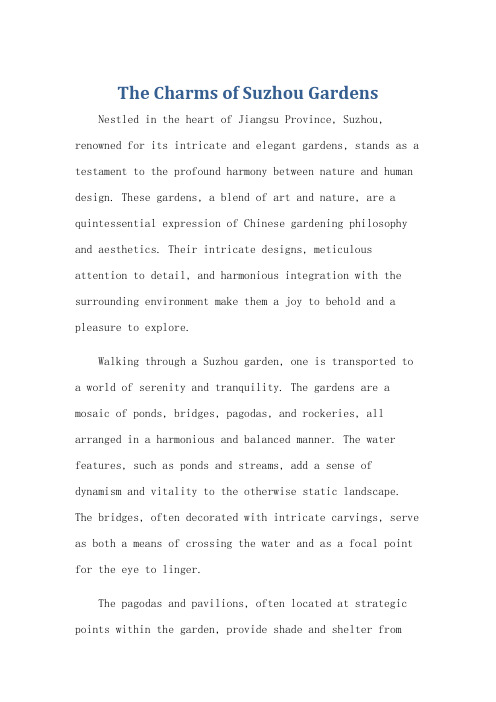
The Charms of Suzhou GardensNestled in the heart of Jiangsu Province, Suzhou, renowned for its intricate and elegant gardens, stands as a testament to the profound harmony between nature and human design. These gardens, a blend of art and nature, are a quintessential expression of Chinese gardening philosophy and aesthetics. Their intricate designs, meticulous attention to detail, and harmonious integration with the surrounding environment make them a joy to behold and a pleasure to explore.Walking through a Suzhou garden, one is transported to a world of serenity and tranquility. The gardens are a mosaic of ponds, bridges, pagodas, and rockeries, all arranged in a harmonious and balanced manner. The water features, such as ponds and streams, add a sense of dynamism and vitality to the otherwise static landscape. The bridges, often decorated with intricate carvings, serve as both a means of crossing the water and as a focal point for the eye to linger.The pagodas and pavilions, often located at strategic points within the garden, provide shade and shelter fromthe elements, while also serving as architectural highlights. The rockeries, often crafted from carefully selected stones, create a sense of naturalism and add texture and depth to the landscape.But what truly sets Suzhou gardens apart is their subtle use of space and light. The gardens are designed to maximize the use of natural light, with carefully placed windows and openings that allow sunlight to filter in, creating dappled patterns on the ground and walls. This play of light and shadow adds an ethereal quality to the gardens, making them seem even more enchanting and dreamlike.The plants and flowers used in Suzhou gardens are also carefully chosen to complement the overall design and theme of the garden. Bamboo, lotus, and willows are common choices, as they are symbols of purity, elegance, and resilience in Chinese culture. The gardens are also filled with seasonal flowers, which bloom throughout the year, adding color and vitality to the landscape.In addition to their visual appeal, Suzhou gardens also serve as a repository of cultural and historicalsignificance. Many of the gardens were built by wealthy merchants and scholars as a retreat from the hustle and bustle of city life. They were places where one could meditate, contemplate, and appreciate the finer points of life. As such, they reflect the tastes, values, and aspirations of their creators, providing a window into the past and a connection to the rich cultural heritage of Suzhou.Moreover, the gardens have also inspired countless poets and artists throughout the ages. Their beauty and tranquility have served as a source of inspiration for countless works of poetry, painting, and calligraphy. Even today, they continue to attract visitors from all over the world, who come to marvel at their beauty and appreciate the wisdom and craftsmanship behind their creation.In conclusion, the gardens of Suzhou are not just a testament to the skill and vision of their creators, but also a symbol of the harmonious coexistence between humans and nature. They are a living example of the Chinese philosophy of "Tianrenheyi" (harmony between human and nature) and a reminder of the importance of preserving andcherishing our natural environment. As we continue to navigate the complexities of modern life, the gardens of Suzhou offer a haven of peace and tranquility, a placewhere we can reconnect with nature and find solace in its embrace.**苏州园林的魅力**苏州,坐落于江苏省的心脏地带,以其错综复杂、优雅别致的园林闻名于世。
关于苏州园林的英语作文80词三段
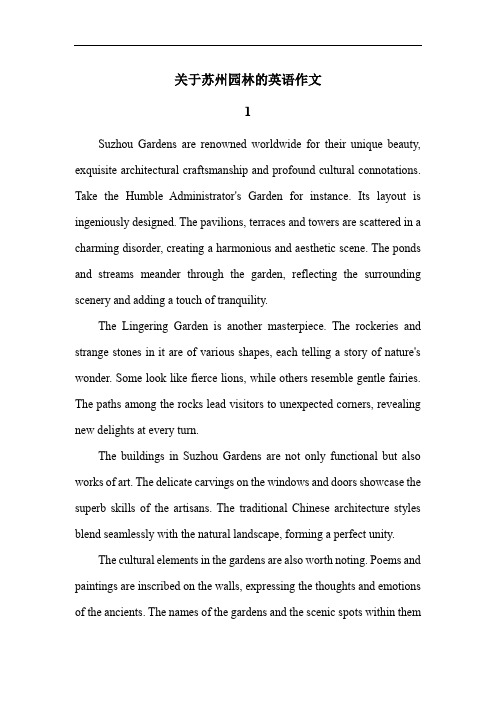
关于苏州园林的英语作文1Suzhou Gardens are renowned worldwide for their unique beauty, exquisite architectural craftsmanship and profound cultural connotations. Take the Humble Administrator's Garden for instance. Its layout is ingeniously designed. The pavilions, terraces and towers are scattered in a charming disorder, creating a harmonious and aesthetic scene. The ponds and streams meander through the garden, reflecting the surrounding scenery and adding a touch of tranquility.The Lingering Garden is another masterpiece. The rockeries and strange stones in it are of various shapes, each telling a story of nature's wonder. Some look like fierce lions, while others resemble gentle fairies. The paths among the rocks lead visitors to unexpected corners, revealing new delights at every turn.The buildings in Suzhou Gardens are not only functional but also works of art. The delicate carvings on the windows and doors showcase the superb skills of the artisans. The traditional Chinese architecture styles blend seamlessly with the natural landscape, forming a perfect unity.The cultural elements in the gardens are also worth noting. Poems and paintings are inscribed on the walls, expressing the thoughts and emotions of the ancients. The names of the gardens and the scenic spots within themcarry profound meanings, reflecting the wisdom and philosophy of Chinese culture.In conclusion, Suzhou Gardens are a precious heritage of human civilization. They not only showcase the beauty of nature and architecture but also carry forward the rich cultural traditions. Visiting these gardens is like stepping into a dreamland of history and art.2Suzhou Gardens are renowned for their exquisite artistry and profound embodiment of traditional Chinese aesthetics. Take the Lion Grove Garden, for instance. Its rockery group is like a fascinating maze, full of intrigue and charm. As one wanders through the labyrinthine paths, they are constantly delighted by the unexpected turns and hidden corners. The rocks, meticulously arranged, seem to tell stories of nature's capriciousness and the ingenuity of human design.Another gem is the Master-of-Nets Garden. Its waterside pavilions and winding corridors create an atmosphere of serenity and elegance. The gentle ripples of the water reflect the surrounding architecture, blurring the boundaries between reality and reflection. The corridors, with their intricate carvings and delicate decorations, invite visitors to stroll along, lost in thoughts of a bygone era.The design of Suzhou Gardens is a harmonious blend of nature and architecture. The ponds, with their lotus blossoms and swimming fish,bring vitality to the otherwise static structures. The carefully pruned trees and shrubs add a touch of softness and grace. The use of space is masterful, with every corner and every view carefully crafted to create a sense of balance and beauty.In conclusion, Suzhou Gardens are not just a collection of beautiful landscapes but a testament to the rich cultural heritage and artistic prowess of China. They continue to inspire and captivate people from all over the world, inviting them to experience the essence of traditional Chinese aesthetics.3Suzhou Gardens are renowned for their exquisite beauty and unique charm. These gardens are not merely a collection of plants and architectures but a masterpiece of art that showcases the perfect harmony between nature and human creativity.When visiting the Canglang Pavilion, one can be deeply impressed by the seamless integration of nature and artificial elements. The gentle flow of water, the elegant pavilions, and the lush greenery all blend together in a captivating manner. It offers a serene and peaceful atmosphere, allowing visitors to escape the hustle and bustle of daily life and immerse themselves in the tranquility. Here, one can truly appreciate the wisdom and craftsmanship of the ancient garden designers.The Yipu Garden, on the other hand, is known for its small butexquisite layout. Every corner of this garden is meticulously designed. The winding paths, the delicate rockeries, and the charming ponds create a sense of intimacy and coziness. As you stroll through the garden, you feel as if you have entered a private world of beauty and refinement.In conclusion, Suzhou Gardens are a precious heritage that showcases the elegance and sophistication of Chinese culture. They provide visitors with an unforgettable experience, inviting them to explore and discover the beauty and harmony that lies within.4Suzhou Gardens are renowned worldwide for their exquisite beauty and profound cultural significance. Among them, the Huánxiù Mountain Villa and the Ou Yuan stand out as remarkable examples, each with its own unique charm while sharing certain commonalities.The Huánxiù Mountain Villa is characterized by its ingenious spatial arrangement. The layout is meticulously designed to create a sense of depth and mystery. The paths wind through the garden, leading visitors on a delightful journey of discovery. The use of rockeries and ponds adds a touch of natural grandeur.In contrast, the Ou Yuan emphasizes harmony and balance. The symmetrical design of the buildings and the neatly arranged flora present a sense of order and tranquility. The ponds in the Ou Yuan are often surrounded by pavilions, creating a serene and peaceful atmosphere.Another pair worth comparing is the Tiger Hill and the Tuisi Garden. The Tiger Hill holds deep cultural connotations related to history and legends. It evokes a sense of awe and reverence. On the other hand, the Tuisi Garden is more about reflection and retreat. It symbolizes a withdrawal from the hustle and bustle of the world, providing a haven for inner peace.In conclusion, although these Suzhou Gardens have their individual features, they all embody the essence of traditional Chinese garden art. They are masterpieces that blend nature and human creativity, inviting people to immerse themselves in the beauty and wisdom they offer.5Suzhou Gardens, a masterpiece of Chinese landscape architecture, have a long and glorious history that dates back centuries. These gardens are not just a collection of beautiful plants and structures; they are a living testament to the artistic and cultural heritage of China.The development of Suzhou Gardens can be traced through various dynasties. Each period added its own unique touch and refinement, shaping these gardens into the masterpieces we admire today. From the elaborate designs of the Ming Dynasty to the delicate craftsmanship of the Qing Dynasty, every element was carefully crafted to create a harmonious blend of nature and human artistry.The influence of Suzhou Gardens extends far beyond theirgeographical boundaries. They have served as an inspiration for garden designs not only in neighboring regions but also around the world. The concept of creating a peaceful retreat, a microcosm of nature within a confined space, has been adopted and adapted by many. The use of water features, rockeries, and pavilions in a strategic and aesthetically pleasing manner has set a benchmark for landscape design globally.The significance of Suzhou Gardens lies not only in their physical beauty but also in the philosophical and cultural values they embody. They represent the Chinese pursuit of harmony between humans and nature, a balance that is often lacking in our modern, fast-paced world. The meticulous attention to detail, the interplay of light and shadow, and the seamless integration of architecture with the natural environment make Suzhou Gardens a true wonder of the world.In conclusion, Suzhou Gardens stand as an irreplaceable gem in the world of garden art, a source of pride for China and a source of inspiration for all who appreciate the beauty and wisdom of nature and human creation.。
苏州园林英语作文100字简单版
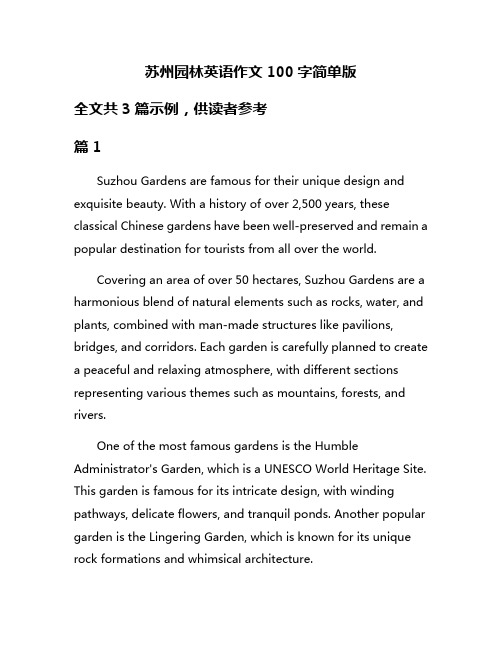
苏州园林英语作文100字简单版全文共3篇示例,供读者参考篇1Suzhou Gardens are famous for their unique design and exquisite beauty. With a history of over 2,500 years, these classical Chinese gardens have been well-preserved and remain a popular destination for tourists from all over the world.Covering an area of over 50 hectares, Suzhou Gardens are a harmonious blend of natural elements such as rocks, water, and plants, combined with man-made structures like pavilions, bridges, and corridors. Each garden is carefully planned to create a peaceful and relaxing atmosphere, with different sections representing various themes such as mountains, forests, and rivers.One of the most famous gardens is the Humble Administrator's Garden, which is a UNESCO World Heritage Site. This garden is famous for its intricate design, with winding pathways, delicate flowers, and tranquil ponds. Another popular garden is the Lingering Garden, which is known for its unique rock formations and whimsical architecture.Visitors to Suzhou Gardens can take a leisurely stroll, admire the stunning scenery, and enjoy traditional Chinese tea in one of the many teahouses scattered throughout the gardens. It is a truly immersive experience that allows visitors to step back in time and appreciate the artistry and craftsmanship of ancient Chinese garden design.In conclusion, Suzhou Gardens are a must-visit destination for anyone interested in Chinese culture and history. The beauty and tranquility of these gardens are unparalleled, making them a true gem in the heart of Suzhou.篇2Suzhou Gardens are well-known for their exquisite design and tranquil atmosphere. Situated in the ancient city of Suzhou, these gardens have a long history and are a perfect blend of nature, architecture, and culture.Suzhou Gardens are famous for their classical Chinese landscaping features, such as small bridges, flowing water, pavilions, and lush greenery. The delicate balance of these elements creates a harmonious and peaceful environment that allows visitors to relax and enjoy the beauty of nature.One of the most famous Suzhou Gardens is the Humble Administrator's Garden. This garden dates back to the 16th century and is a UNESCO World Heritage Site. It features winding pathways, picturesque ponds, and meticulously manicured plants, making it a popular destination for tourists and locals alike.Another renowned Suzhou Garden is the Lingering Garden, which is known for its intricate rock formations and traditional Chinese architecture. Visitors can explore quaint courtyards, wander through bamboo groves, and admire the stunning views of the garden's famous bonsai trees.Overall, Suzhou Gardens are a must-visit destination for anyone interested in Chinese culture and history. The peaceful and serene atmosphere of these gardens provides a welcome escape from the hustle and bustle of everyday life, allowing visitors to connect with nature and appreciate the beauty of traditional Chinese landscaping.篇3Suzhou GardensSuzhou Gardens, also known as Suzhou Classical Gardens, are a series of gardens located in Suzhou, Jiangsu province,China. These gardens are renowned for their unique design, exquisite craftsmanship, and rich cultural significance.The Suzhou Gardens were first built during the Ming Dynasty (1368-1644) and have been well-preserved ever since. They are considered a masterpiece of Chinese garden art and have been recognized as a UNESCO World Heritage Site.One of the most famous Suzhou Gardens is the Humble Administrator's Garden, which is the largest garden in Suzhou and dates back to 1509. It features a large pond, pavilions, and intricate landscaping that symbolize traditional Chinese philosophy and aesthetics.Another notable garden is the Lingering Garden, which was built in 1583 and is known for its exquisite rockeries, ponds, and pavilions. The garden is designed to create a serene and harmonious environment that reflects the balance of nature.In addition to the Humble Administrator's Garden and the Lingering Garden, Suzhou has many other beautiful gardens, each with its own unique charm and history. Visitors to Suzhou can explore these gardens to gain a deeper appreciation for Chinese culture, history, and art.Overall, Suzhou Gardens are a must-visit destination for anyone interested in traditional Chinese architecture and landscaping. They provide a peaceful retreat from the hustle and bustle of modern life and offer a glimpse into China's rich cultural heritage.。
英语作文介绍苏州园林

英语作文介绍苏州园林Suzhou gardens are a unique and beautiful part of Chinese culture. These gardens are known for theirexquisite design, delicate architecture, and tranquil atmosphere. Visitors can stroll through the winding paths, admire the elegant pavilions, and enjoy the serene ponds and lush greenery.The gardens in Suzhou are a perfect blend of natural beauty and human artistry. Each garden has its own distinct style and features, showcasing the creativity and skill of the ancient craftsmen. From the classical Lingering Garden to the charming Master of the Nets Garden, each garden offers a different experience and a glimpse into the rich history and culture of Suzhou.One of the most striking features of Suzhou gardens is the use of water elements. The gardens are often built around ponds, with bridges, walkways, and pavilions creating a harmonious and picturesque scene. The sound offlowing water and the reflection of the surrounding buildings create a sense of tranquility and peace, making the gardens a perfect place for relaxation and contemplation.In addition to their natural beauty, Suzhou gardens are also a testament to the ingenuity of Chinese garden design. The intricate layout, the use of space, and the careful arrangement of plants and rocks all contribute to the aesthetic appeal of the gardens. Visitors can appreciate the attention to detail and the artistic vision that went into creating these timeless masterpieces.Suzhou gardens are not just a feast for the eyes, but also a reflection of Chinese philosophy and culture. The gardens are designed to evoke a sense of harmony and balance, with elements such as rocks, water, and plants symbolizing the unity of nature and humanity. By exploring the gardens, visitors can gain a deeper understanding of traditional Chinese values and aesthetics.Overall, Suzhou gardens are a must-visit destinationfor anyone interested in Chinese culture and history. The gardens offer a peaceful retreat from the hustle and bustle of modern life, allowing visitors to immerse themselves in the beauty and tranquility of traditional Chinese garden design. Whether you are a nature lover, an art enthusiast, or a history buff, Suzhou gardens have something to offer for everyone.。
苏州园林英语作文小学生
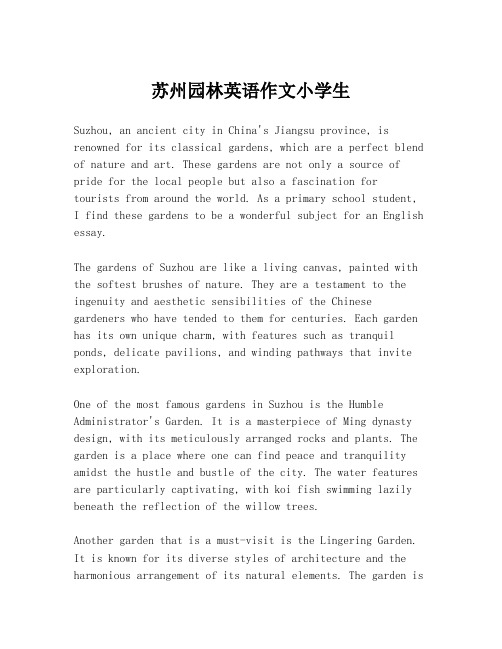
苏州园林英语作文小学生Suzhou, an ancient city in China's Jiangsu province, is renowned for its classical gardens, which are a perfect blend of nature and art. These gardens are not only a source of pride for the local people but also a fascination fortourists from around the world. As a primary school student, I find these gardens to be a wonderful subject for an English essay.The gardens of Suzhou are like a living canvas, painted with the softest brushes of nature. They are a testament to the ingenuity and aesthetic sensibilities of the Chinese gardeners who have tended to them for centuries. Each garden has its own unique charm, with features such as tranquil ponds, delicate pavilions, and winding pathways that invite exploration.One of the most famous gardens in Suzhou is the Humble Administrator's Garden. It is a masterpiece of Ming dynasty design, with its meticulously arranged rocks and plants. The garden is a place where one can find peace and tranquility amidst the hustle and bustle of the city. The water features are particularly captivating, with koi fish swimming lazily beneath the reflection of the willow trees.Another garden that is a must-visit is the Lingering Garden. It is known for its diverse styles of architecture and the harmonious arrangement of its natural elements. The garden isdivided into several sections, each with a different theme, such as the Scholar's Courtyard and the Lady's Garden. The use of space and the interplay of light and shadow create a serene and contemplative atmosphere.Visiting these gardens is like stepping into a different world, where time seems to slow down and the beauty of nature is celebrated. The gardens are not just places for relaxation but also serve as an inspiration for artists and poets. They are a source of cultural heritage and a symbol of the city's rich history.In conclusion, the gardens of Suzhou are a treasure trove of Chinese horticultural artistry. They offer a glimpse into the past and a connection to the natural world that is increasingly rare in our modern lives. As a student, I am inspired by the beauty and wisdom of these gardens, and I hope to share this wonder with others through my writing. The gardens of Suzhou are not just a destination for travelers but a journey into the heart of Chinese culture and the soul of nature.。
写苏州园林的英语作文
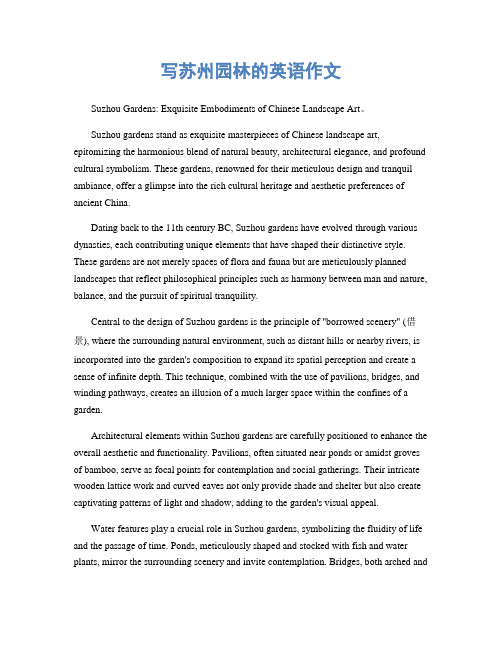
写苏州园林的英语作文Suzhou Gardens: Exquisite Embodiments of Chinese Landscape Art。
Suzhou gardens stand as exquisite masterpieces of Chinese landscape art, epitomizing the harmonious blend of natural beauty, architectural elegance, and profound cultural symbolism. These gardens, renowned for their meticulous design and tranquil ambiance, offer a glimpse into the rich cultural heritage and aesthetic preferences of ancient China.Dating back to the 11th century BC, Suzhou gardens have evolved through various dynasties, each contributing unique elements that have shaped their distinctive style. These gardens are not merely spaces of flora and fauna but are meticulously planned landscapes that reflect philosophical principles such as harmony between man and nature, balance, and the pursuit of spiritual tranquility.Central to the design of Suzhou gardens is the principle of "borrowed scenery" (借景), where the surrounding natural environment, such as distant hills or nearby rivers, is incorporated into the garden's composition to expand its spatial perception and create a sense of infinite depth. This technique, combined with the use of pavilions, bridges, and winding pathways, creates an illusion of a much larger space within the confines of a garden.Architectural elements within Suzhou gardens are carefully positioned to enhance the overall aesthetic and functionality. Pavilions, often situated near ponds or amidst groves of bamboo, serve as focal points for contemplation and social gatherings. Their intricate wooden lattice work and curved eaves not only provide shade and shelter but also create captivating patterns of light and shadow, adding to the garden's visual appeal.Water features play a crucial role in Suzhou gardens, symbolizing the fluidity of life and the passage of time. Ponds, meticulously shaped and stocked with fish and water plants, mirror the surrounding scenery and invite contemplation. Bridges, both arched andflat, span these water features, connecting different parts of the garden and guiding visitors along a carefully choreographed journey through nature.The choice of plants in Suzhou gardens is deliberate and symbolic, with each species selected for its aesthetic qualities, seasonal variation, and cultural significance. Plum blossoms, revered for their resilience and beauty in winter, symbolize endurance and hope. Bamboo, known for its flexibility and strength, represents integrity and humility. These plants are arranged in clusters and along pathways to evoke specific emotions and narratives as visitors explore the garden.Beyond their aesthetic appeal, Suzhou gardens are steeped in cultural and historical significance. They have served as inspirations for poets, painters, and scholars throughout Chinese history, influencing literature, art, and garden design both within China and beyond. The tranquility and serenity offered by these gardens have also made them ideal settings for contemplation, meditation, and the pursuit of scholarly pursuits.In conclusion, Suzhou gardens are not merely physical spaces but living testaments to the ingenuity and creativity of Chinese landscape architects across centuries. Their harmonious integration of natural landscapes, architectural elements, and cultural symbolism continues to inspire and captivate visitors from around the world, offering a timeless sanctuary where the beauty of nature and the wisdom of human endeavor converge harmoniously.。
2018年6月大学英语四级翻译练习题:苏州园林
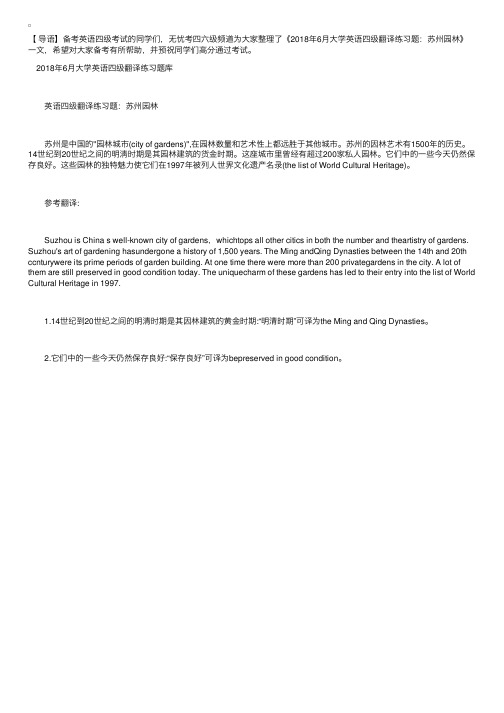
【导语】备考英语四级考试的同学们,⽆忧考四六级频道为⼤家整理了《2018年6⽉⼤学英语四级翻译练习题:苏州园林》⼀⽂,希望对⼤家备考有所帮助,并预祝同学们⾼分通过考试。
2018年6⽉⼤学英语四级翻译练习题库 英语四级翻译练习题:苏州园林 苏州是中国的"园林城市(city of gardens)",在园林数量和艺术性上都远胜于其他城市。
苏州的因林艺术有1500年的历史。
14世纪到20世纪之间的明淸时期是其园林建筑的货⾦时期。
这座城市⾥曾经有超过200家私⼈园林。
它们中的⼀些今天仍然保存良好。
这些园林的独特魅⼒使它们在1997年被列⼈世界⽂化遗产名录(the list of World Cultural Heritage)。
参考翻译: Suzhou is China s well-known city of gardens,whichtops all other citics in both the number and theartistry of gardens. Suzhou's art of gardening hasundergone a history of 1,500 years. The Ming andQing Dynasties between the 14th and 20th ccnturywere its prime periods of garden building. At one time there were more than 200 privategardens in the city. A lot of them are still preserved in good condition today. The uniquecharm of these gardens has led to their entry into the list of World Cultural Heritage in 1997. 1.14世纪到20世纪之间的明清时期是其因林建筑的黄⾦时期:“明清时期”可译为the Ming and Qing Dynasties。
- 1、下载文档前请自行甄别文档内容的完整性,平台不提供额外的编辑、内容补充、找答案等附加服务。
- 2、"仅部分预览"的文档,不可在线预览部分如存在完整性等问题,可反馈申请退款(可完整预览的文档不适用该条件!)。
- 3、如文档侵犯您的权益,请联系客服反馈,我们会尽快为您处理(人工客服工作时间:9:00-18:30)。
题目:苏州园林(汉译英)
要求:
Direction: Translate the following paragraph into English.
苏州园林是中国古典园林最杰出的代表,大部分为私家所有。
苏州园林始于春秋,兴于宋元,盛于明清。
清末苏州已有各色园林170余处,为其赢得了“园林之城”的称号。
现保存完好的有60多处,对外开放的有10余处。
其中沧浪亭(The Surging Wave Pavilion)、狮子林(The Lion Grove Garden)、拙政园(The Humble Administrator’s Garden) 和留园(The Lingering Garden)分别代表着宋、元、明、清四个朝代的艺术风格,被称为“苏州四大名园”。
苏州园林宅园合一,可赏,可游,可居,其建筑规制反映了中国古代江南民间的生活方式和礼仪习俗。
苏州园林不仅是历史文化的产物,同时也是中国传统思想文化的载体。
1997年,苏州园林被联合国教科文组织列入“世界遗产名录”。
参考译文:Classical Gardens of Suzhou are the most outstanding representatives of classical Chinese gardens. Most of them were privately-owned. The gardens first appeared in the Spring and Autumn Period, developed in the Song and Yuan dynasties. By the late Qing Dynasty, Suzhou had got as many as over 170 gardens of diverse styles, winning it the name “The City of Garden”. Now, over 60 gardens are kept in good condition, more than 10 of which are open to the public. The Surging Wave Pavilion, the Lion Grove Garden, the Humble Administrator’s Garden and the Lingering Ga rden are called the four most famous gardens in Suzhou, representing the artistic styles of the Song, Yuan, Ming and Qing dynasties respectively. Suzhou gardens are assemblies of residences and gardens, which makes them suitable places for appreciating, visiting and living. The architectural principles of the gardens are a demonstration of the lifestyles and social customs of the ancient Chinese people in the south of the Lower Yangtze River. Classical Gardens of Suzhou are not only a product of Chinese history and culture, but also a carrier of traditional Chinese ideology and culture. In 1997, Classical Gardens of Suzhou were placed on the World Heritage List by UNESCO.。
